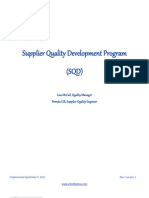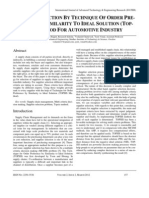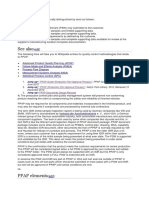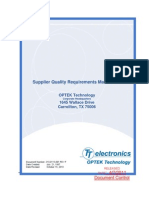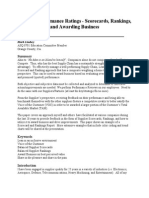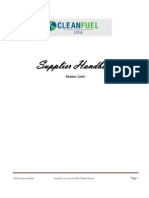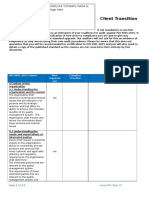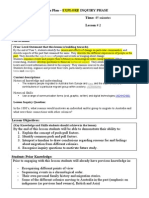TP11 Supplier Evaluation System MTUFN
TP11 Supplier Evaluation System MTUFN
Uploaded by
castor2010Copyright:
Available Formats
TP11 Supplier Evaluation System MTUFN
TP11 Supplier Evaluation System MTUFN
Uploaded by
castor2010Copyright
Available Formats
Share this document
Did you find this document useful?
Is this content inappropriate?
Copyright:
Available Formats
TP11 Supplier Evaluation System MTUFN
TP11 Supplier Evaluation System MTUFN
Uploaded by
castor2010Copyright:
Available Formats
MTU Friedrichshafen Supplier Evaluation Handout
SES
Supplier Evaluation System
QLPE
2014/01 TPML, Ralf Muelller Page 1 of 8
MTU Friedrichshafen Supplier Evaluation Handout
Definition The Supplier Evaluation System (SES) of MTU Friedrichshafen GmbH is used for target suppliers. With these suppliers, MTU intends to cover most of its future procurement volume. This system was developed to form a standard basis for the evaluation of existing and potential target suppliers. Evaluation is based on major criteria including purchasing, quality, logistics and environment which are again detailed in sub-criteria. Fulfillment of these criteria is measured on a scale between 0 and 100 points by applying specific definitions. Taking into account weighting factors, this results in rates for the fulfillment of the main criteria on which the overall assessment is based. Depending on the point score, a supplier is evaluated as A, B or C-supplier (A = 100-80 points, B = 79-60 points, C = 59-0 points). B-suppliers are asked to correct any existing deficiencies. C-suppliers are asked to introduce urgent corrective measures. Repeated assessment as a C-supplier jeopardizes the target supplier status. MTU aims at maintaining long-term supplier relations with A or B suppliers.
Philosophy This supplier evaluation system is based on a philosophy which intends to find solutions, uncover potential and develop existing strengths in cooperation with the suppliers and on the basis of the results and comparative figures determined; on the other hand, it also provides for the development and implementation of solutions and alternatives for existing weaknesses. Suppliers are regarded as partners who can help counteract the ever-increasing competitive pressure.
Target The target of this supplier evaluation system is the objective and standardized evaluation of suppliers by applying the criteria referred to above. This objectivity makes it possible to directly compare suppliers with each other and thus reveals the strengths and weaknesses of individual suppliers. The system of specified evaluation criteria facilitates achievement of this target.
Criteria and weighting
Main criterion
Weighting Objective Sub-criteria [points]
PPM
Weighting
60% 10% 10% 10% 10% 70% 10% 10% 10% 30% 30% 20% 10% 10%
____
Manual/ automatic determination
automatic automatic automatic manual manual automatic automatic
Quality
40%
100
Sample complaints rate Rate of residual quality costs Audit Support quality Meeting delivery deadlines Supplying agreed quantities
Logistics
25%
100
Logistical supply quality Support logistics Price level Price development
automatic
manual manual manual manual manual manual manual
Purchasing
25%
100
Proposals for cost reduction Financial stability Support purchasing
Environment
10%
100
__________________
2014/01 TPML, Ralf Muelller
Page 2 of 8
MTU Friedrichshafen Supplier Evaluation Handout
Handling
Criteria which can be determined automatically are updated each month. Manual criteria are evaluated once per year (January) for the previous year and continue to be applicable for the current year until the next evaluation.
Description of Criteria
Main criterion: Quality Sub-criteria PPM - rate Sample complaints rate Rate of residual quality costs 60% 10% 10% Points 100 0-99 100 0-99 100 0-99
0 PPM
Weighting: 40% Evaluation basis
PPM rate >0 (for a description refer to page 4) Complaints rate 0 % Complaints rate >0 % (for a description refer to page 4) No residual quality costs Rate of residual quality costs proportional to incoming-goods value >0 % (for a description refer to page 4) This criterion is evaluated by the respective audit heads based on the following aspects:
Audit / Preliminary evaluation
Audit grade assigned only if entire process chain has been audited.
10%
0-100
Number / type of complaints Organization, tidiness, cleanliness at suppliers facility Cooperation during audit Intensity of follow-up of measures (not possible with initial audits) Activities for quality improvement Certification
Support quality
(The following are taken into account: response time and quality of 8D reports; information provision/handling; pro-active approach re. quality problems; reaction to enquiries; contacts and their availability/contactability; flexibility.)
10%
100 80 60 40 20 0
Excellent cooperation and flexibility Good cooperation and flexibility Average cooperation and flexibility Below-average cooperation and flexibility Poor cooperation and flexibility Very poor cooperation and flexibility
2014/01 TPML, Ralf Muelller
Page 3 of 8
MTU Friedrichshafen Supplier Evaluation Handout
Determination of point score for PPM rate:
The PPM rate is determined for each supplier on the basis of
major goods groups. Using degressive conversion tables which orientate themselves to the average PPM rate per goods group, a point score is determined for each goods group which is then calculated proportionally to the value of incoming goods of the respective goods group before being added.
Example: 50.000 ppm for unmachined castings 50.000 ppm for machined castings Sales share of machined cast. 70*0.75 + 53*0.25 = 70 pts. = 53 pts. = 25% = 65.75 pts.
Determination of point score for sample complaints rate: The sample complaints rate is calculated by the number of quality notifications (of sample orders) in relation to the number of sample deliveries. Example: 5 samples deliveries 1 quality notification (of sample orders) 20% sample complaints rate 25 points
Determination of point score for residual quality costs: Residual quality costs are determined separately for raw materials and finished parts. Using degressive conversion tables, a prorata point score is calculated proportionally to the pro-rata value of incoming goods before the points for raw materials and finished parts are added.
2014/01 TPML, Ralf Muelller
Page 4 of 8
MTU Friedrichshafen Supplier Evaluation Handout
Main criterion: Logistics Sub-criteria Points
Weighting: 25% Evaluation basis
Automatic determination via SAP based on the following criteria: Determination of average schedule compliance of all incoming goods per month. The evaluation of purchase orders and delivery schedules is derived from the following point system: Delay of up to two days* 100 points; 4/80; 6/60; 12/40; 20/20; >20days/1 point(s)
Meeting delivery deadlines
70%
1-100
Premature delivery up to five days 100 points; 10/80; 15/60; 20/40; 30/20; >30 days/1 point(s) *The aim is delivery exactly on schedule. Due to possible unforeseen problems (e.g. during transportation), a leeway of two days is granted. For delivery schedules, backlog status is also evaluated. The first time backlogs appear in the delivery schedule, 60 points are allocated (compliance with deadline and volume). The second time, 40 points are allocated in each instance. The objective for approved delivery deadlines is fixed for all suppliers at 100 points!
Automatic determination via SAP based on the following criteria: Determination of average quantity compliance of all incoming goods per month. The evaluation of purchase orders and delivery schedules is derived from the following point system:
Supplying agreed quantities
10%
1-100
Excess supply of more than 2% 90 points; 4/80; 6/70;8/60; 10/50; 12/40; 14/30; 16/20; 18/10; 20% 1 point(s) Short supply of more than 2% 90 points; 4/80; 6/70;8/60; 10/50; 12/40; 14/30; 16/20; 18/10; 20% 1 point(s)
For delivery schedules, backlog status is also evaluated. The first time backlogs appear in the delivery schedule, 60 points are allocated (compliance with deadline and volume). The second time, 40 points are allocated in each instance.
Automatic determination via SAP based on the following criteria:
Logistical supply quality
10%
0-100
No. of quality reports logistic in relation to no. of deliveries 0% - 10% claimed deliveries 100 points to 0 points > linear evaluation; 10% of claimed deliveries = 0 points
Support Logistics
(taken into account: batch size; reacquisition times, packaging requirements; proactive management of product start-up/changes; process integration - supplier adapts to meet MTU requirements and achieves high level of process consistency; provision/handling of information; pro-active approach to supply problems; reaction to enquiries; processing of reminders/warnings; contacts and their availability / contactability; flexibility re. short-notice requests, delivery call-offs, direct call-offs.)
100 80 60 10% 40 20
Excellent cooperation and flexibility Good cooperation and flexibility Average cooperation and flexibility Below-average cooperation and flexibility Poor cooperation and flexibility
Very poor cooperation and flexibility
2014/01 TPML, Ralf Muelller
Page 5 of 8
MTU Friedrichshafen Supplier Evaluation Handout
Main criterion: Purchasing Sub-criteria Points 100 60 0 100 60 0 100 60 0 100 90 80
60
Weighting: 25% Evaluation basis
Suppliers prices are within target range Suppliers prices are outside target range Suppliers prices are well outside target range Price development is within target range Price development is outside target range Price development is well outside target range Supplier with frequent proposals on cost reduction Supplier with occasional proposals on cost reduction Supplier without proposals on cost reduction
Price level
30%
Price development Proposals for cost reduction
30%
20%
Rating
Financial stability is proved or ensured via affiliation with Group. Financial stability seems to be ensured subjectively. No verified information available Deliveries to MTU only against cash in advance or bank guaranties. Or: Suppliers who have been rated as critical. Supplier is involved in insolvency proceedings! Excellent cooperation and flexibility Very good cooperation with SEmL ; frequently makes own proposals Good cooperation and flexibility Good cooperation with SEmL; occasionally makes own proposals Average cooperation and flexibility Cooperation with SEmL, shows own initiative now and then Below-average cooperation and flexibility Below-average cooperation with SEmL, hardly any own initiative Poor cooperation and flexibility Poor cooperation with SEmL, no own initiative Very poor cooperation and flexibility No cooperation with SEmL AAA AA A BBB BB B C, D
Financial stability
10%
40
20
0 100 80 Support purchasing
(SEmL assessment only if relevant)
10%
60 40 20 0
Note: Evaluation between fixed point scores is also possible.
2014/01 TPML, Ralf Muelller
Page 6 of 8
MTU Friedrichshafen Supplier Evaluation Handout
Main criterion: Environment Points 100 80 60 0
Weighting: 10% Evaluation basis
Environmental certification available (ISO14001, EMAS ) Environmental certification aimed for within 18 months or MTU audit re. environment OK. Compliance with legislation, technological status or No information available. No identifiable environmental awareness; supplier development necessary.
Note: A 0-point score for the major criterion "Environment" will not be accepted permanently by MTU. If no activities for improvement can be observed, the business relationship will be terminated.
Conversion table / grade <> points
Grade 1,0 1,5 2,0 2,5 3,0 3,5 4,0 4,5 5,0 5,5 6,0 excellent excellent good good good fair fair fair needs improvement needs improvement needs impr. needs signif. impr needs significant improvement needs signif. impr.- unacceptable unacceptable Points 100 90 80 70 60 50 40 30 20 10 0
2014/01 TPML, Ralf Muelller
Page 7 of 8
MTU Friedrichshafen Supplier Evaluation Handout
Example:
2014/01 TPML, Ralf Muelller
Page 8 of 8
You might also like
- G4 ComperhensionDocument144 pagesG4 Comperhensionwalaa magdy100% (1)
- Year7 - Ancient China - Unit OverviewDocument15 pagesYear7 - Ancient China - Unit Overviewapi-237976105100% (2)
- Supplier Quality Management A Complete Guide - 2020 EditionFrom EverandSupplier Quality Management A Complete Guide - 2020 EditionNo ratings yet
- HDT First Article Inspection Policy 01Document7 pagesHDT First Article Inspection Policy 01Srinivasan VenkatNo ratings yet
- Supplier Quality Development ProgramDocument16 pagesSupplier Quality Development ProgramBrenda Gill100% (1)
- Supplier Manual TribarDocument17 pagesSupplier Manual TribarAvyan Kelan100% (1)
- Chapter 8 Supplier Quality ManagementDocument28 pagesChapter 8 Supplier Quality Managementsantiny san100% (1)
- Cobbledick Layered Process Audits PDFDocument22 pagesCobbledick Layered Process Audits PDFelyesNo ratings yet
- GM 1927 08 Potential Supplier Assessment (PSA)Document12 pagesGM 1927 08 Potential Supplier Assessment (PSA)Juan Carlos Murillo Larrota100% (1)
- Volume2 CrossSectorUnitsFinalNovember2015Document286 pagesVolume2 CrossSectorUnitsFinalNovember2015Khan Mohammad Mahmud Hasan17% (6)
- Supplier Quality AssuranceDocument5 pagesSupplier Quality Assurancefatimaheman647No ratings yet
- Supplier RatingDocument16 pagesSupplier Rating41175100% (1)
- Supplier Quality Management System A Complete Guide - 2020 EditionFrom EverandSupplier Quality Management System A Complete Guide - 2020 EditionNo ratings yet
- Global Supplier Standards Manual Quality Expectations SectionDocument18 pagesGlobal Supplier Standards Manual Quality Expectations Sectionamhosny64No ratings yet
- 9AKK102951 ABB Supplier Qualification QuestionnaireDocument6 pages9AKK102951 ABB Supplier Qualification Questionnairesudar1477No ratings yet
- Supplier Selection by Technique of Order Pre-Ference by Similarity To Ideal Solution (Top-Sis) Method For Automotive IndustryDocument4 pagesSupplier Selection by Technique of Order Pre-Ference by Similarity To Ideal Solution (Top-Sis) Method For Automotive IndustryJoseph WilliamsNo ratings yet
- Process Capability Statistics: CPK vs. PPK: Rational SubgroupsDocument33 pagesProcess Capability Statistics: CPK vs. PPK: Rational SubgroupsAgustinus SitioNo ratings yet
- PpapDocument3 pagesPpapVlad NitaNo ratings yet
- Borgwarner Supplier ManualDocument63 pagesBorgwarner Supplier ManualBertha Uribe100% (1)
- Supplier QADocument41 pagesSupplier QAMoraru CiprianNo ratings yet
- Supplier Quality System Audit Checklist - Elbit Systems of AmericaDocument8 pagesSupplier Quality System Audit Checklist - Elbit Systems of Americaamirkhakzad498No ratings yet
- Vda Application Form For ExamDocument3 pagesVda Application Form For ExamVivek km100% (1)
- Supplier EvaluationDocument2 pagesSupplier EvaluationIonut EduardNo ratings yet
- Supplier Performance RatingsDocument7 pagesSupplier Performance RatingsSrijan SrivastavaNo ratings yet
- Docslide - Us - gm1927 35 Run at Rate gp9 ProcedureDocument9 pagesDocslide - Us - gm1927 35 Run at Rate gp9 ProcedureCarlos silvaNo ratings yet
- Adverse Event Log TemplateDocument2 pagesAdverse Event Log TemplateLore LopezNo ratings yet
- 03 Ppap-3 PDFDocument91 pages03 Ppap-3 PDFMalla Reddy AVNo ratings yet
- CFUSA Supplier HandbookDocument24 pagesCFUSA Supplier HandbookBrenda GillNo ratings yet
- AS9100D 2016 Checklist - SafetyCultureDocument80 pagesAS9100D 2016 Checklist - SafetyCulturePANDIYANNo ratings yet
- 04 The Six Sigma MethodologyDocument53 pages04 The Six Sigma Methodologychteo1976No ratings yet
- A A 59316Document5 pagesA A 59316Victor Parvan100% (1)
- GP KPI Index-Card Supplier-PerformanceDocument20 pagesGP KPI Index-Card Supplier-PerformanceSaldi AhmadNo ratings yet
- Foreign Vendor Assessment Program PDFDocument13 pagesForeign Vendor Assessment Program PDFAbdhel X-MetaNo ratings yet
- Effective Auditing of Purchasing & Subtier Supplier Control ProcessesDocument40 pagesEffective Auditing of Purchasing & Subtier Supplier Control ProcessesJHBernardoNo ratings yet
- Suppliers Evaluation: No. Criteria. Rating: 1 (Poorest) To 3 (Best) Supplier ADocument2 pagesSuppliers Evaluation: No. Criteria. Rating: 1 (Poorest) To 3 (Best) Supplier AsgtplclNo ratings yet
- Entrenamiento 5WDocument42 pagesEntrenamiento 5WSerchecko JaureguiNo ratings yet
- Measure 6 Gage R&R - Short MethodDocument2 pagesMeasure 6 Gage R&R - Short Methodanjo0225100% (1)
- Auto Part Manufacturing ProcessDocument4 pagesAuto Part Manufacturing ProcessKuldeep BohraNo ratings yet
- Aiag Ppap Forms June 2013 ModDocument7 pagesAiag Ppap Forms June 2013 ModAdriana Martínez SorianoNo ratings yet
- Supplier Quality & Development Engineer 80-100% in Turgi, Aargau, Switzerland - Procurement & Logistics at ABBDocument4 pagesSupplier Quality & Development Engineer 80-100% in Turgi, Aargau, Switzerland - Procurement & Logistics at ABBmoiNo ratings yet
- CMQ Practice QuestionsDocument47 pagesCMQ Practice QuestionsMusman SattarNo ratings yet
- Quality Control: A Brief Introduction About QUALITY SYSTEMS in M/s. AADHIRA CNC Product PVT LTDDocument25 pagesQuality Control: A Brief Introduction About QUALITY SYSTEMS in M/s. AADHIRA CNC Product PVT LTDsridharanNo ratings yet
- Introduction To Control PlansDocument6 pagesIntroduction To Control Plansamarchavan894No ratings yet
- The 5-Whys' Method: Example 1Document3 pagesThe 5-Whys' Method: Example 1initiative1972No ratings yet
- Best Practices in Supplier Quality ManagementDocument8 pagesBest Practices in Supplier Quality ManagementNaman KhandelwalNo ratings yet
- Solving Manufacturing ProblemsDocument40 pagesSolving Manufacturing ProblemsSomsak NavayonNo ratings yet
- When To Conduct A First Article InspectionDocument4 pagesWhen To Conduct A First Article InspectionCloud RedfieldNo ratings yet
- Hirschmann Supplier GuidelineDocument17 pagesHirschmann Supplier GuidelineTin NguyenNo ratings yet
- GM1927-Global Supplier Quality ManualDocument126 pagesGM1927-Global Supplier Quality ManualJordi Palomar100% (1)
- PPAP Fourth Edition 2006Document5 pagesPPAP Fourth Edition 2006Đại Hữu Tuấn MaiNo ratings yet
- Critical Dimensions TolerancingDocument3 pagesCritical Dimensions TolerancingSelvaraj BalasundramNo ratings yet
- KMMG Supplier QDocument32 pagesKMMG Supplier QClaudia PEÑANo ratings yet
- Production Part Approval ProcessDocument5 pagesProduction Part Approval Processapi-3701058No ratings yet
- Supplier Quality ManagerDocument7 pagesSupplier Quality ManagersaravanakumarpalaniNo ratings yet
- Supplier Management V4 PDFDocument13 pagesSupplier Management V4 PDFRx DentviewNo ratings yet
- 7.2.18 DFMEA-PFMEA-FMECA Comparison Guidance 13JUL2020Document4 pages7.2.18 DFMEA-PFMEA-FMECA Comparison Guidance 13JUL2020Moti Ben-ZurNo ratings yet
- Supplier AuditDocument37 pagesSupplier Auditjacksodb100% (1)
- Supplier Assesment MaxionDocument23 pagesSupplier Assesment Maxionesivaks2000No ratings yet
- ISO 9001-2015 Client-Transition-Checklist - Add Your Co NameDocument11 pagesISO 9001-2015 Client-Transition-Checklist - Add Your Co NameTomBerendsenNo ratings yet
- Capability Study With His To Gram Excel TemplateDocument3 pagesCapability Study With His To Gram Excel TemplatenithyachatsuNo ratings yet
- BilingualDocument21 pagesBilingualcattleya abelloNo ratings yet
- PED 5 HandoutDocument3 pagesPED 5 HandoutKaren CastorNo ratings yet
- Aarsh Colleage Principal EvaluationDocument20 pagesAarsh Colleage Principal EvaluationArya SamajNo ratings yet
- Psychological AssessmentDocument28 pagesPsychological AssessmentKkrNo ratings yet
- Cpast Rubric WatermarkDocument11 pagesCpast Rubric Watermarkapi-604277894No ratings yet
- FS 2 Activity 4 FERRERNICA L.Document36 pagesFS 2 Activity 4 FERRERNICA L.Prince GamingNo ratings yet
- Development of Classroom Assessment Tool1Document6 pagesDevelopment of Classroom Assessment Tool1mariegold mortola fabelaNo ratings yet
- Srs TemplateDocument3 pagesSrs Templateapi-288315210No ratings yet
- Dissertation Teaching Taboo TopicsDocument278 pagesDissertation Teaching Taboo TopicsgeotrumpetNo ratings yet
- Part 3: Critical ReflectionDocument6 pagesPart 3: Critical ReflectionakimazmanNo ratings yet
- Man301 HRM - Ueh-Isb - Unit GuideDocument13 pagesMan301 HRM - Ueh-Isb - Unit GuideMai Trần0% (1)
- RPMS Portfolio Grade4Document32 pagesRPMS Portfolio Grade4Cir Roy Villaos ReboladoNo ratings yet
- Class 10Document16 pagesClass 10RamNo ratings yet
- ESL Textbook RubricDocument2 pagesESL Textbook RubricRicardo Ribeiro100% (1)
- Module 3 Principles of High Quality AssessmentDocument17 pagesModule 3 Principles of High Quality AssessmentAljon Andol OrtegaNo ratings yet
- LESSON PLAN Sounds of A Cowhide DrumDocument7 pagesLESSON PLAN Sounds of A Cowhide DrumJonathan Frederick Lee ChingNo ratings yet
- The Design of Discrete Vocabulary TestsDocument4 pagesThe Design of Discrete Vocabulary TestsPiroska SzolnokiNo ratings yet
- Cfe 1 - HistoryDocument8 pagesCfe 1 - Historyapi-302761689No ratings yet
- E5 A1PosterTable4Document1 pageE5 A1PosterTable4steffb23No ratings yet
- Lesson 2 - ExploreDocument5 pagesLesson 2 - Exploreapi-265620665No ratings yet
- English Speaking Competency Enhancement of Grade 10 Students IN CBSUA-LHS SY 2017-2018Document35 pagesEnglish Speaking Competency Enhancement of Grade 10 Students IN CBSUA-LHS SY 2017-2018Dave VasquezNo ratings yet
- Project Evaluation Form PDFDocument20 pagesProject Evaluation Form PDFMuneesh WariNo ratings yet
- Delone and Mclean Is Success Model (ISSM) 2003Document18 pagesDelone and Mclean Is Success Model (ISSM) 2003Megat Shariffudin Zulkifli, Dr100% (1)
- Educ TechDocument13 pagesEduc TechAlliane Jake AlicanteNo ratings yet
- History and Citizenship S3 Adapted TG 2022Document262 pagesHistory and Citizenship S3 Adapted TG 2022niyonzimajaphet96No ratings yet
- BTLED Course DescriptionDocument11 pagesBTLED Course DescriptionAlleah LuciaNo ratings yet
- Let 24Document31 pagesLet 24Hanima S. DaudNo ratings yet




